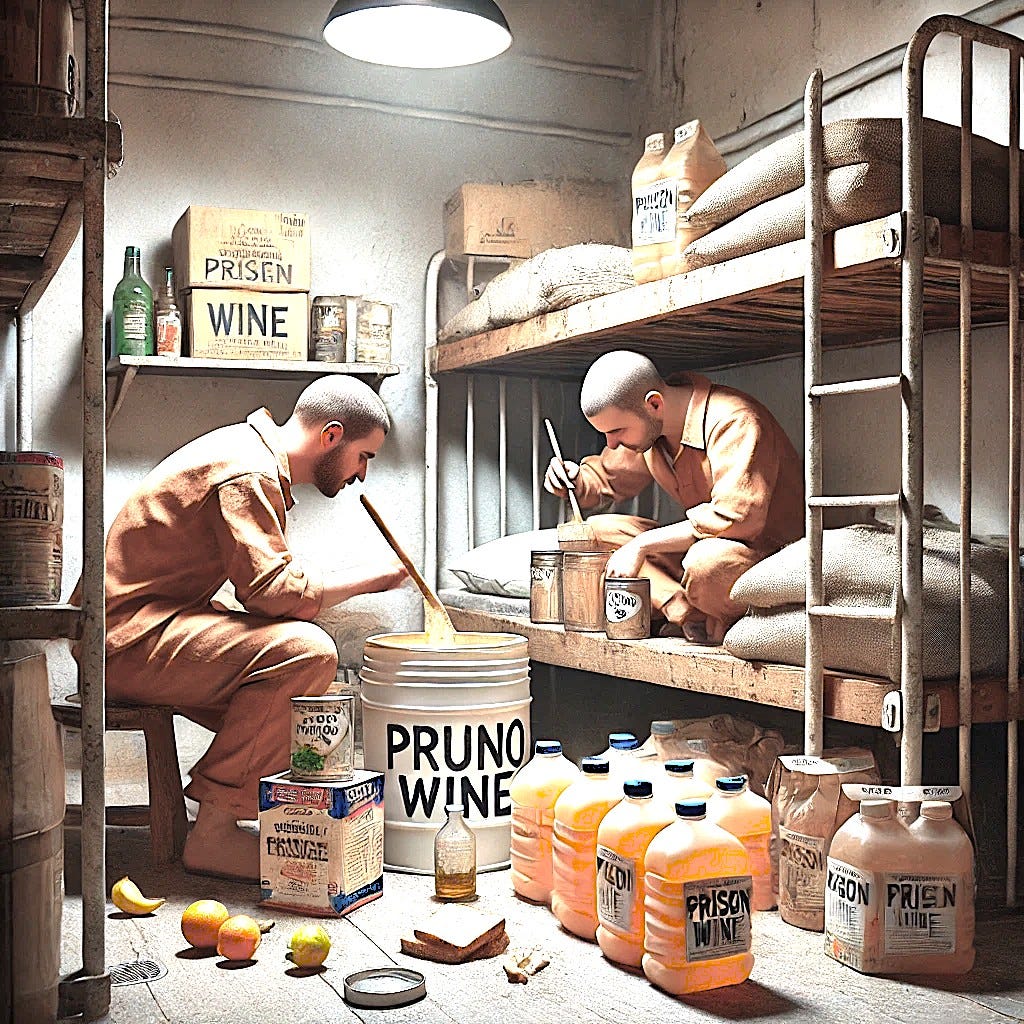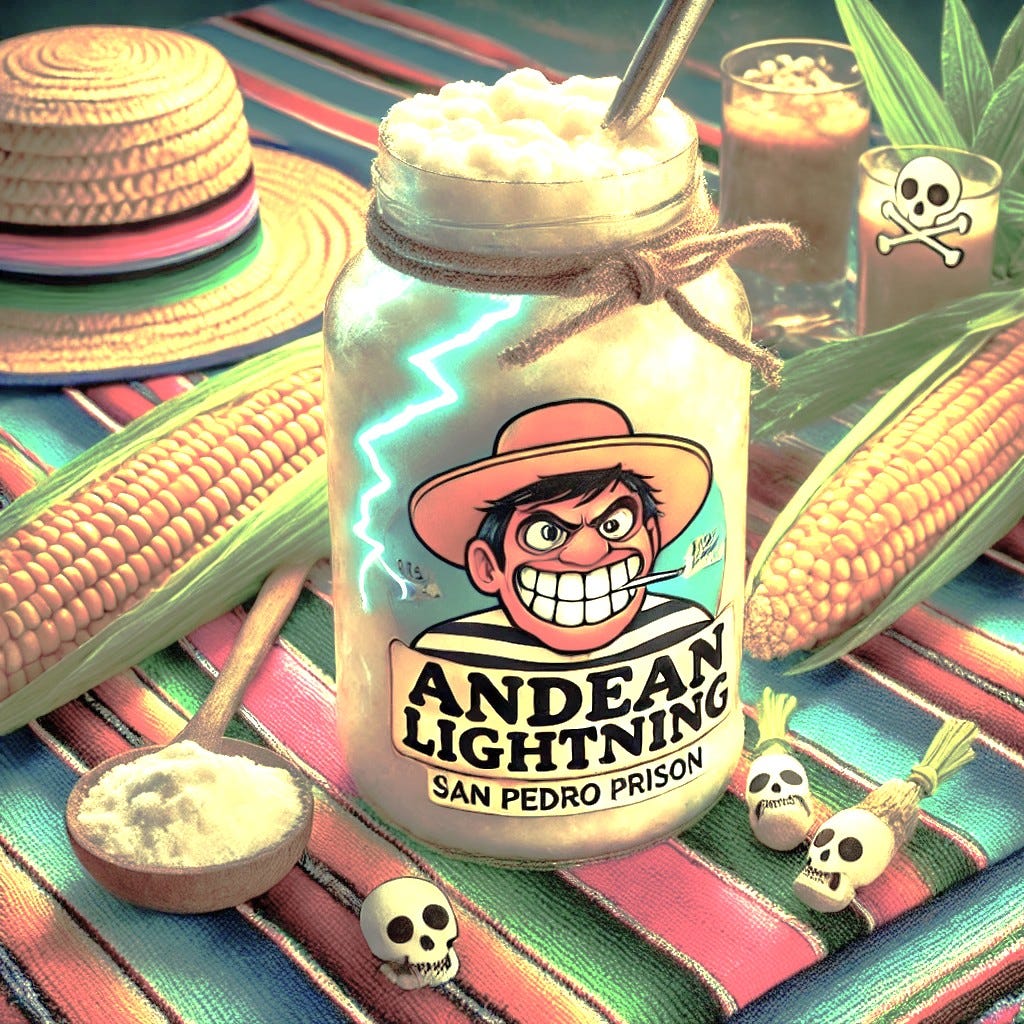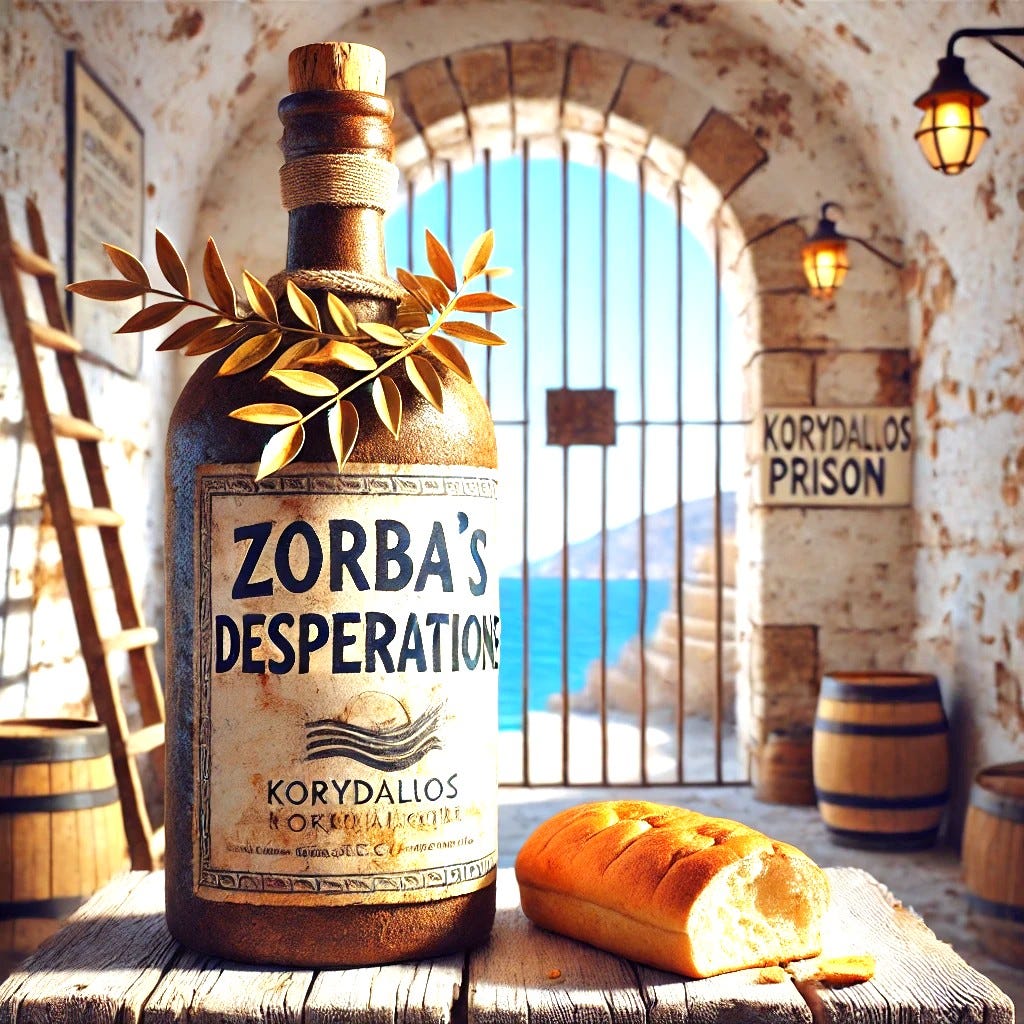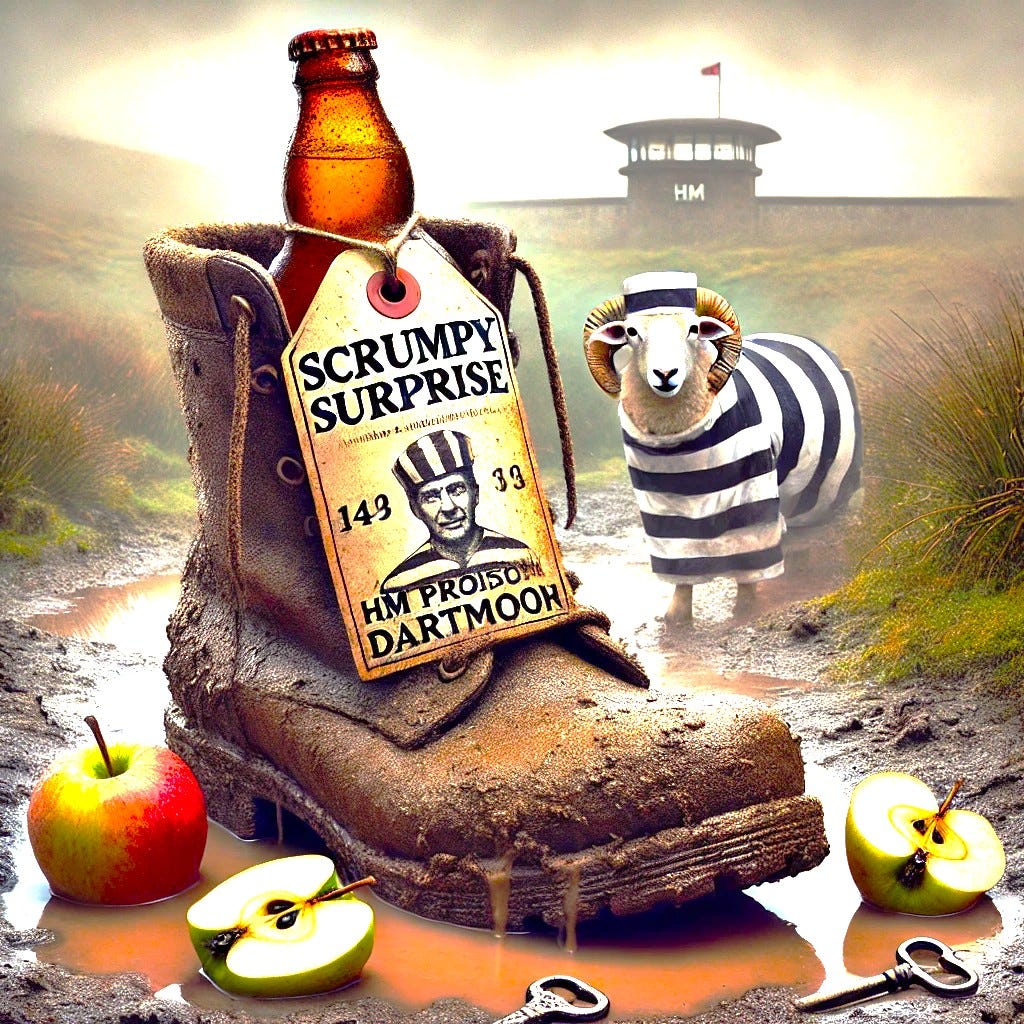Welcome to the gritty underworld of Pruno, Hooch and Compton Thug Juice as we take a spirited tour of prison wine culture around the world.
Just as terroir influences the finest vineyards, each prison brings its unique charm - or perhaps, its unique lack of it - to the art of fermented contraband.
Prison wine is an improvised alcoholic beverage crafted by inmates using accessible ingredients within correctional facilities. Production of “Hooch” is testament to human ingenuity as it involves fermenting items like fruit, sugar and bread in makeshift containers under clandestine conditions.
The term “Hooch” is believed to have originated from the Hoochinoo tribe of Alaska. In the late 19th century, the Hoochinoo people were known for brewing their own potent homemade alcohol using fermented molasses and sugar. Their moonshine became known as “hoochinoo” or simply “hooch,” a name that stuck and became widely used for any type of bootleg or homemade alcohol, especially during Prohibition.
The origin of the term "Pruno” is less certain but is often linked to the term prune, as early versions of prison wine often included prunes or prune juice, which provided fermentable sugars. Over time, inmates in U.S. prisons and jails began using the term “Pruno” to describe any wine-like alcoholic drink made from fermented fruit, sugar and sometimes bread.
The tradition of inmates producing homemade alcohol dates back to the early 20th century, particularly during the Prohibition era in the United States (1920-1933). With the nationwide ban on alcohol, individuals resorted to creating illicit brews, a practice that permeated into prison systems.
Guide to Making Prison Wine
The process of making prison wine is relatively straightforward but requires resourcefulness due to the limited availability of ingredients and equipment:
Step Number 1: Gather your ingredients whilst not getting shanked
Look for fermentable items such as fruits (oranges, apples, raisins), sugar packets and bread. The natural sugars in fruits and added sugars serve as the primary fermentable material. The best way to do this is to get a job in the Prison Cafeteria - try bribing your way to the position using cigarettes.
Step Number 2: Prepare the mash
The collected fruits are mashed and crushed to release their juicy juices. Bread, containing yeast, is often added to initiate the fermentation process. You can also use other sources of yeast or rely on natural fermentation.
Step Number 3: Fermentation
In a flash, the mash is dashed into a stash - be it a bag or a glass flask - and stashed in a warm, dark cache to ferment. This splash of flavors starts with a bash, then slowly turns brash, as time ticks from days to a week - whatever it takes to reach the peak. The hash of ingredients clash and crash, creating a drink both strange and rash.
Step Number 4: Consumption
Once fermentation is complete, the liquid is strained to remove solid residues and consumed. The resulting beverage typically has a low to moderate alcohol content and a taste that varies based on the ingredients used and fermentation duration.
But what of the differences in Prison Wines?
Due to the ingenuity of Cell-block Sommelier, let’s explore the global flavors and stories behind five notorious prison wines. Remember, these are not yet registered or approved Cru.
Alcatraz – The Fog Grog
Alcatraz, located on a rocky island in San Francisco Bay, operated as a federal prison from 1934 to 1963. Known as “The Rock,” it housed some of America's most notorious criminals, including Al Capone, George "Machine Gun" Kelly and Silas “the Clown Killer” McCready. The prison was famed for its high security and the belief that escape was impossible due to the cold, strong currents surrounding the island and the hipsters of San Francisco.
Inmates at Alcatraz, ever resourceful, would scavenge kitchen scraps to craft their illicit brew. The island's limited vegetation meant that fruits like oranges and raisins, often smuggled from the mess hall became the primary fermentable ingredients. Fermentation would occur in hidden containers, sometimes utilizing the island's damp, cool climate to their advantage. The result was the infamous "The Fog Grog," a cloudy concoction with a tangy citrus bite and a hint of mustiness, reminiscent of the island's perpetual fog.
La Santé Prison, Paris – La Chaussée Rouge
Established in 1867, La Santé Prison is one of France's most notorious correctional facilities, located in the heart of Paris. Over the years, it has housed a mix of political prisoners, notorious criminals and traitors to the French such as the Russian actor, Gerard Depardieu and Officer Crabtree from the television documentary series, “Allo, Allo!".”
In the culinary capital of the world even prison wine aspires to sophistication. Inmates at La Santé would ferment a blend of beets and any available fruit peels, occasionally sweetened with smuggled sugar cubes. The fermentation process often took place in makeshift containers hidden within the prison's ancient stone walls. The resulting "La Chaussée Rouge" boasted a deep red hue, earthy undertones from the beets and a surprisingly sweet finish.
San Pedro Prison, Bolivia – Andean Lightning
San Pedro Prison in La Paz is unlike any other; it operates as a self-governed community where inmates' families often live alongside them. The prison is known for its unique social structure, with prisoners running gift shops, fine-dining restaurants, setting up Air BnB and even a Prison Wine Bar. This unconventional setup has made San Pedro a subject of intrigue and study.
Leveraging the Andean region's rich agricultural produce, inmates craft “Andean Lightning” using fermented corn, known locally as chicha - they combine this with cocoa leaves and sugarcane. Fermentation occurs in communal areas, with batches often traded as currency within the prison's economy. The beverage is potent, with a cloudy appearance and a sweet, tangy flavor profile, embodying the high-altitude zest of the Andes.
Korydallos Prison, Greece – Zorba’s Desperation
Located in Athens, Korydallos Prison is Greece's largest correctional facility, primarily housing pre-trial detainees and those serving short sentences. Over the years, it has been criticized for overcrowding and inadequate conditions, leading to numerous reforms and public outcry.
Drawing inspiration from Greece's rich winemaking heritage, inmates produce “Zorba’s Desperation” by fermenting raisins, sugar, and bread - ingredients reminiscent of traditional Greek wine production. The fermentation process often takes place in plastic bags hidden within personal belongings. The brew is a sweet, robust wine with a strong alcoholic kick, offering a fleeting escape to the sun-drenched vineyards of the Greek isles.
HM Prison Dartmoor, UK – Scrumpy Surprise
Established in 1809, Dartmoor Prison is situated in the desolate moorlands of Devon, England. Originally built to house French and American prisoners of war, it later became a high-security facility for Britain's most hardened criminals, such as Cockney Sommelier, Jake Botcher’s Grandfather, “Bertie “Buttons” Botcher.” The prison's remote location and harsh weather conditions and wild rabid sheep have made it infamous over the centuries.
In the heart of cider country, it's no surprise that inmates concoct “Scrumpy Surprise.” Utilizing leftover apple cores, sugar and bread yeast, prisoners ferment their brew in hidden containers, sometimes even in hollowed-out books. The cool, damp climate of Dartmoor slows fermentation, resulting in a cloudy, tart cider with a yeasty undertone. Move over Champagne!
Prisoner #47310
"The King of Prison Wine"
Born in the back alleys of New York’s Little Italy in 1898, Matty Capriesta was a small-time bootlegger with a big-time palate.
Growing up around family members who swore that homemade wine was a “sacrament, not sin,” Matty developed a taste for fermented fruits early on. But it wasn’t until he started dabbling in counterfeit wine labels and “vintage juice” scams during Prohibition that his reputation grew beyond his local block. He got caught printing Lafite wallpaper in rolls to “decorate his home.”
At his trial, Matty claimed he was “a simple wine enthusiast and businessman with a knack for creativity,” the judge had no sympathy for his blending skills.
Shipped off to Alcatraz in 1934, Matty’s knack for “creative fermentation” didn’t go unnoticed. From day one, he scouted kitchen scraps, fruit rinds and smuggled sugar packets, quickly establishing himself as the prison’s resident wine master. Other inmates dubbed him "The King of Prison Wines," and his infamous "Fog Grog" brew became legendary within the cell blocks. Though far from his once-famed “Bordeaux,” Matty’s cell-brewed hooch was good enough to keep Al Capone himself coming back for a taste.
While the creation of prison wine is illegal and poses health risks due to unsanitary production methods and potential for contamination, its existence underscores the lengths to which individuals will go to assert agency and maintain cultural practices, even in constrained circumstances.
From the citrusy undertones of The Fog Grog to the earthy depth of La Chaussée Rouge, each wine reflects the unique environment, available resources and cultural backdrop of its origin, proving that even behind bars, the human spirit ferments creativity in the most unexpected ways.
Long live Prison Wines and their unique Terroir!











